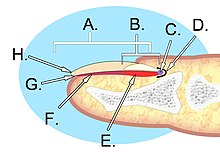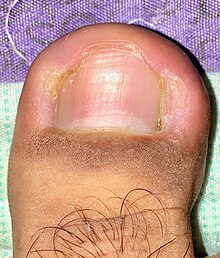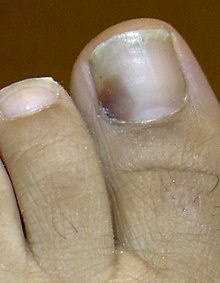

This article needs additional citations for verification. Please help improve this articlebyadding citations to reliable sources. Unsourced material may be challenged and removed.
Find sources: "Nail disease" – news · newspapers · books · scholar · JSTOR (February 2024) (Learn how and when to remove this message) |
| Nail disease or disorder | |
|---|---|
 | |
| Onychia without granuloma | |
| Specialty | Dermatology |
Anail diseaseoronychosis is a disease or deformity of the nail. Although the nail is a structure produced by the skin and is a skin appendage, nail diseases have a distinct classification as they have their own signs and symptoms which may relate to other medical conditions. Some nail conditions that show signs of infectionorinflammation may require medical assistance.




Nail inspection can give hints to the internal condition of the body as well. Nail disease can be very subtle and should be evaluated by a dermatologist with a focus in this particular area of medicine. A nail technician may be the first to note a subtle change in nail health.[2][3][4]
In approximately half of suspected nail fungus cases there is actually no fungal infection, but only some nail dystrophy.[7] Before beginning oral antifungal therapy the health care provider should confirm a fungal infection.[7] Administration of treatment to persons without an infection is unnecessary health care and causes needless exposure to side effects.[7]
|
Congenital malformations and deformations of skin appendages
| |
|---|---|
| Nail disease |
|
| Hair disease |
|
| Authority control databases: National |
|
|---|